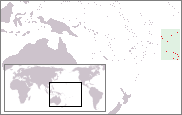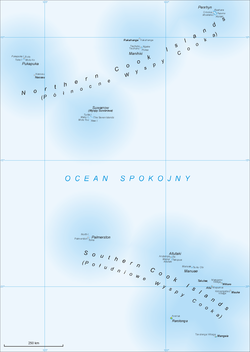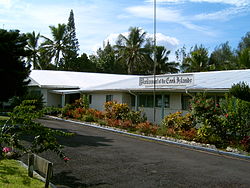| Cook Islands Kūki 'Āirani | ||||||
|---|---|---|---|---|---|---|
| ||||||
| Anthem: Te Atua Mou E God is Truth | ||||||
| Capital (and largest city) | Avarua 21°12′S 159°46′W / 21.2°S 159.767°W | |||||
| Official language(s) | English Cook Islands Māori | |||||
| Ethnic groups | 87.7% Māori, 5.8% part Māori, 6.5% other [1] | |||||
| Demonym | Cook Islander | |||||
| Government | Constitutional monarchy | |||||
| - | Head of State | Queen Elizabeth II | ||||
| - | Queen's Representative | Sir Frederick Tutu Goodwin | ||||
| - | Prime Minister | Henry Puna | ||||
| Associated state | ||||||
| - | Self-government in free association with New Zealand | 4 August 1965 | ||||
| - | Independence in foreign relations recognized by the UN[2] | 1992 | ||||
| Area | ||||||
| - | Total | 240 km2 (210th) 91 sq mi | ||||
| Population | ||||||
| - | 2006 census | 19,569 (213th) | ||||
| - | Density | 76/km2 (124th) 197/sq mi | ||||
| GDP (PPP) | 2005 estimate | |||||
| - | Total | $183.2 million (not ranked) | ||||
| - | Per capita | $9,100 (not ranked) | ||||
| Currency | New Zealand dollar (Cook Islands dollar also used) ( NZD) | |||||
| Time zone | (UTC-10) | |||||
| Drives on the | left | |||||
| ISO 3166 code | CK | |||||
| Internet TLD | .ck | |||||
| Calling code | 682 | |||||
The Cook Islands /ˈkʊk ˈaɪləndz/ (![]() listen) (Cook Islands Māori: Kūki 'Āirani[citation needed]) is a self-governing parliamentary democracy in free association with New Zealand. The 15 small islands in this South Pacific Ocean country have a total land area of 240 square kilometres (92.7 sq mi), but the Cook Islands Exclusive Economic Zone (EEZ) covers 1,800,000 square kilometres (690,000 sq mi) of ocean.[3]
listen) (Cook Islands Māori: Kūki 'Āirani[citation needed]) is a self-governing parliamentary democracy in free association with New Zealand. The 15 small islands in this South Pacific Ocean country have a total land area of 240 square kilometres (92.7 sq mi), but the Cook Islands Exclusive Economic Zone (EEZ) covers 1,800,000 square kilometres (690,000 sq mi) of ocean.[3]
The main population centres are on the island of Rarotonga (14,153 as of 2006), where there is an international airport. There is also a much larger population of Cook Islanders in New Zealand, particularly the North Island. In the 2006 census, 58,008 self-identified as being of ethnic Cook Island Māori descent.[4]
With over 90,000 visitors travelling to the islands in 2006, tourism is the country's main industry, and the leading element of the economy, far ahead of offshore banking, pearls, marine and fruit exports.
Defence and foreign affairs are the responsibility of New Zealand, in consultation with the Cook Islands. In recent times, the Cook Islands have adopted an increasingly independent foreign policy. Although Cook Islanders are citizens of New Zealand, they have the status of Cook Islands nationals, which is not given to all New Zealand citizens.
Contents[hide] |
[edit] Geography
The Cook Islands are in the South Pacific Ocean, north-east of New Zealand, between French Polynesia and American Samoa. There are 15 major islands, spread over 2.2 million km² of ocean, divided into two distinct groups: the Southern Cook Islands, and the Northern Cook Islands of coral atolls.[5]
The islands were formed by volcanic activity; the northern group is older and consists of six atolls (sunken volcanoes topped by coral growth). The climate is moderate to tropical.
The 15 islands and two reefs are grouped as follows:
- Southern Cook Islands:
- Nga-pu-Toru ("Three Roots", the group name for the easternmost islands of Southern Group):
- Remaining islands of the South:
- Aitutaki (Araura Enua)
- Mangaia (Auau Enua)
- Rarotonga (Tumutevarovaro) and also with the capital, Avarua.
- Palmerston Island (Pamati) sometimes grouped with the Northern Group.
- Manuae
- Winslow Reef (submerged)
- Northern Cook Islands:
[edit] History

The Cook Islands were first settled in the 6th century CE by Polynesian people who migrated from nearby Tahiti, to the southeast.[6]
Spanish ships visited the islands in the 16th century; the first written record of contact with the Islands came with the sighting of Pukapuka by Spanish sailor Álvaro de Mendaña de Neira in 1595 who called it San Bernardo (Saint Bernard). Portuguese-Spaniard Pedro Fernández de Quirós, made the first recorded European landing in the islands when he set foot on Rakahanga in 1606, calling it Gente Hermosa (Beautiful People).[7]
British navigator Captain James Cook arrived in 1773 and 1777[8] and named the islands the Hervey Islands; the name "Cook Islands", in honour of Cook, appeared on a Russian naval chart published in the 1820s.[9]
In 1813, John Williams, a missionary on the Endeavour (not the same ship as that of Cook), made the first official sighting of the island of Rarotonga.[10] The first recorded landing on Rarotonga by Europeans was in 1814 by the Cumberland; trouble broke out between the sailors and the Islanders and many were killed on both sides.[11] The islands saw no more Europeans until missionaries arrived from England in 1821. Christianity quickly took hold in the culture and many islanders continue to be Christian believers today.
The Cook Islands became a British protectorate in 1888, due largely to community fears that France might occupy the territory as it had Tahiti. In 1901, the New Zealand Government decided to annex the country despite opposition from the country's traditional chiefs. As many of the islands were independent and ruled by local chiefs, the Cook Islands had no federal statutory law to decide the constitutional constraints regarding whether to agree to the country's annexation by the New Zealand Government. Nonetheless, the country remained a New Zealand protectorate until 1965, when the New Zealand Government decided to offer self governing status to its former colony. In that year, Albert Henry of the Cook Islands Party was elected as the first Prime Minister. Sir Albert Henry led the country until he was accused of vote-rigging. He was succeeded in 1978 by Tom Davis of the Democratic Party.
Today, the Cook Islands are essentially independent ("self-governing in free association with New Zealand") but New Zealand is tasked with overseeing the country's defence.
On 11 June 1980, the United States signed a treaty with the Cook Islands specifying the maritime border between the Cook Islands and American Samoa and also relinquishing its claim to the islands of Penrhyn, Pukapuka, Manihiki, and Rakahanga.[12] In 1990 the Cook Islands signed a treaty with France which delimited the boundary between the Cook Islands and French Polynesia.[13]
[edit] Politics
The politics of the Cook Islands takes place in a framework of a parliamentary representative democratic associated state, whereby the Queen of New Zealand, represented in the Cook Islands by the Queen's Representative, is Head of State and the Chief Minister is the head of government. There is a pluriform multi-party system and the islands are self-governing in free association with New Zealand and fully responsible for both internal and external affairs.
New Zealand retains some responsibility for external affairs, in consultation with the Cook Islands. As of 2005, it has diplomatic relations in its own name with 18 other countries. Executive power is exercised by the government. Legislative power is vested in both the government and the Parliament of the Cook Islands.
The Cook Islands is not a United Nations full member but participates in WHO and UNESCO, and is an associate member of the Economic and Social Commission for Asia and the Pacific (UNESCAP).
The Judiciary is independent of the executive and the legislature.
[edit] Administrative subdivisions
There are island councils on all of the inhabited outer islands (Outer Islands Local Government Act 1987, with amendments up to 2004 and Palmerston Island Local Government Act 1993) except Nassau, which is governed by Pukapuka (Suwarrow, with only one caretaker living on the island, also governed by Pukapuka, is not counted with the inhabited islands in this context). Each council is headed by a mayor.
- The ten Outer Islands councils are
 |  | Aitutaki (including uninhabited Manuae) |
 |  | Mangaia |
 |  | Atiu (including uninhabited Takutea) |
 |  | Ma'uke |
 |  | Mitiaro |
 |  | Manihiki |
 |  | Penrhyn |
 |  | Rakahanga |
 | Pukapuka (including Nassau and Suwarrow) | |
 |  | Palmerston |
The three vaka councils of main island Rarotonga established in 1997 (Rarotonga Local Government Act 1997), that were also headed by mayors,[14] were abolished in February 2008, despite much controversy[15]
- The three Vaka councils on the main island Rarotonga were
| Te au o tonga | (equivalent to Avarua, the national capital of the Cook Islands) |
| Puaikura | Arorangi |
| Takitumu | Ngatangiia |
On the lowest level, there are village committees. Nassau, which is governed by Pukapuka, has an island committee (Nassau Island Committee), which advises the Pukapuka Island Council on matters concerning its own island.
[edit] Economy
The Economy of the Cook Islands is strongly affected by the Cook Islands geography. It is isolated from foreign markets, and has inadequate infrastructure. Furthermore, it lacks major natural resources and suffers greatly from natural disasters. Agriculture provides the economic base and manufacturing is limited. The economy is supported by foreign aid, largely from New Zealand. The Peoples Republic of China has also contributed foreign aid which has resulted, among other projects, in the Police Headquarters building. The Cook Islands is expanding its tourism, banking, mining and fishing sectors, with varying success.
[edit] Culture
[edit] Language
The languages of the Cook Islands include English, Cook Islands Māori, or "Rarotongan," and Pukapukan. Dialects of Cook Islands Maori include Penrhyn; Rakahanga-Manihiki; the Ngaputoru dialect of Atiu, Mitiaro, and Mauke; the Aitutaki dialect; and the Mangaian dialect. Cook Islands Maori and its dialectic variants are closely related to both Tahitian and to New Zealand Māori. Pukapukan, by contrast, is considered closely related to the Samoan language. English and Cook Islands Maori are considered official languages of the Cook Islands.
[edit] Music
Music in the Cook Islands is varied, with Christian songs being quite popular, but traditional dancing and songs in Polynesian languages remain popular.
[edit] Public holidays
| Date | Name |
|---|---|
| 1 January | New Year's Day |
| 2 January | Day after New Year's Day |
| The Friday before Easter Sunday | Good Friday |
| The day after Easter Sunday | Easter Monday |
| 25 April | ANZAC Day |
| The first Monday in June | Queen's Birthday |
| During July | Rarotonga Gospel Day |
| 4 August | Constitution Day (Te Maevea Nui Celebrations) |
| 26 October | Gospel Day |
| 25 December | Christmas |
| 26 December | Boxing Day |
[edit] Art
[edit] Carving
Woodcarving is a common art form in the Cook Islands. Sculpture in stone is much rarer although there are some excellent carvings in basalt by Mike Tavioni. The proximity of islands in the southern group helped produce a homogeneous style of carving but which had special developments in each island. Rarotonga is known for its fisherman's gods and staff-gods, Atiu for its wooden seats, Mitiaro, Ma'uke and Atiu for mace and slab gods and Mangaia for its ceremonial adzes. Most of the original wood carvings were either spirited away by early European collectors or were burned in large numbers by missionary zealots. Today, carving is no longer the major art form with the same spiritual and cultural emphasis given to it by the Maori in New Zealand. However, there are continual efforts to interest young people in their heritage and some good work is being turned out under the guidance of older carvers. Atiu, in particular, has a strong tradition of crafts both in carving and local fibre arts such as tapa. Mangaia is the source of many fine adzes carved in a distinctive, idiosyncratic style with the so-called double-k design. Mangaia also produces food pounders carved from the heavy calcite found in its extensive limestone caves.
[edit] Weaving
The outer islands produce traditional weaving of mats, basketware and hats. Particularly fine examples of rito hats are worn by women to church. They are made from the uncurled immature fibre of the coconut palm and are of very high quality. The Polynesian equivalent of Panama hats, they are highly valued and are keenly sought by Polynesian visitors from Tahiti. Often, they are decorated with hatbands made of minuscule pupu shells which are painted and stitched on by hand. Although pupu are found on other islands the collection and use of them in decorative work has become a speciality of Mangaia. The weaving of rito is a speciality of the northern island of Penrhyn.
[edit] Tivaevae
A major art form in the Cook Islands is tivaevae. This is, in essence, the art of handmade Island scenery patchwork quilts. Introduced by the wives of missionaries in the 19th century, the craft grew into a communal activity and is probably one of the main reasons for its popularity.
[edit] Contemporary Art
The Cook Islands has produced internationally recognised contemporary artists, especially in the main island of Rarotonga. Artists include painter (and photographer) Mahiriki Tangaroa, sculptors Eruera (Ted) Nia (originally a film maker) and master carver Mike Tavioni, painter (and Polynesian tattoo enthusiast) Upoko’ina Ian George, Aitutakian-born painter Tim Manavaroa Buchanan, Loretta Reynolds, Judith Kunzlé, Joan Rolls Gragg, Kay George (who is also known for her fabric designs), Apii Rongo, and multi-media, installation and community-project artist Ani O'Neil, all of whom currently live on the main island of Rarotonga. Atiuan-based Andrea Eimke is an artist who works in the medium of tapa and other textiles, and also co-authored the book 'Tivaivai - The Social Fabric of the Cook Islands' with British academic Susanne Kuechler. Many of these artists have studied at university art schools in New Zealand and continue to enjoy close links with the New Zealand art scene.
New Zealand-based Cook Islander artists include Michel Tuffrey, print-maker David Teata, Richard Shortland Cooper, Sylvia Marsters, and Jim Vivieaere.
On Rarotonga, the main commercial galleries are Beachcomber Contemporary Art (Taputapuatea, Avarua) run by Ben Bergman, and The Art Gallery ('Arorangi). The Cook Islands National Museum also exhibits art.
[edit] Wildlife
- The national flower of the Cook Islands is the Tiare māori or Tiale māoli (Penrhyn, Nassau, Pukapuka).[16]
- The Cook Islands are infested with Kiore toka (Ship rat[17] and Polynesian rat[18]). The infestation has devastated the bird population on the islands.[19]
- In April 2007 27 Kuhl's Lorikeet were re-introduced to Atiu from Rimatara. Fossil and oral traditions indicate that the species was formerly on at least five islands of the southern group. Excessive exploitation for its red feathers is the most likely reason for the species's extinction in the Cook Islands.[20]
[edit] Sport
Rugby union is the most popular sport in the Cook Islands.[21] Association football (soccer) and rugby league are also popular.[citation needed]
(copy of wikipedia)








No comments:
Post a Comment